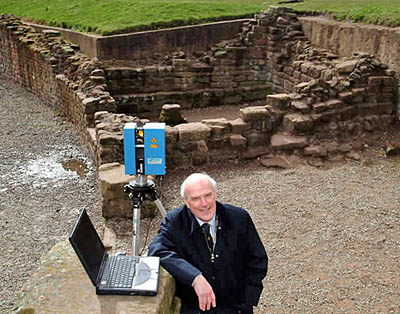|
English Heritage
A Building in Use is a Building Saved
By Sharon Gehl
 Sir Neil Cossons, Chairman of English Heritage, with hi-tech laser scanning equipment. Photo courtesy Chester Amphitheatre Project.
|
You might think that historic conservation is about keeping things the same, but ideas about conservation have continually changed over the years in this country and around the world. This reality was illustrated in a talk given by Sir Neil Cossons, the Chairman of English Heritage, at the Getty Conservation Institute on March 19th, as part of their 2004-2005 lecture series.
English Heritage, Scottish Heritage and Welsh Heritage are the three government agencies in charge of heritage issues in Britain. English Heritage has responsibility for well-known historic properties such as Stonehenge, Hadrian's Wall and Queen Victoria's summer palace. They also decide which private properties will be certified historic and who can display one of their famous "Blue Plaques", provide most of the funding for archeological research in England, and survey properties to decide which should be preserved. A recent example of the latter proactive approach was a study of thousands of old cinemas that resulted in the listing of about 30 of the most important ones.
The preservation movement that started in Britain in the 19th Century didn't envision preserving cinemas; it reflected the thinking of its time about what should be preserved. Now English Heritage is working to preserve important parts of English history from the 19th century through World War II, a remarkable period of time that saw the country go from the world's first industrial country to a post industrial service economy, build the world's largest Imperial Empire and then lose it.
The country sees a need now to pull together things that tell about that period, such as the world's first iron bridge, built in 1779, and a group of the world's earliest surviving water powered mills north of Darby on the river Derment. When these mills were new, people came from all over the world to learn about revolutionary new technologies for making iron or weaving cloth. How best to preserve a mill, ideally by keeping it in operation. Rolled and wrought iron is still being made in some early factories, and the last English stream powered weaving mill is still in operation.
Cossons also talked about efforts to preserve the historic jewelry district in Birmingham. He said that people recognize places, not buildings. So to save buildings you need to think of the whole area. Beginning with a few workshops in the 1820s, a large district of small interconnected workshops developed that produced large quantities of jewelry and silverware. Each workshop would do one part of the manufacturing process and then pass the work on to the next shop. What had been a residential section became an area of workshops full of benches next to windows that let in light to work by. As economic conditions changed, the number of shops declined, until 5 years ago only 2,000 people worked in the district, hardly enough to make the local industry viable. English Heritage worked to consolidate the quarter, so that it could prosper again. There are 3,000 workers in the area now, the public can buy from craftsmen at local shops, and one factory has been turned into a school to teach art and train new craftsmen. Saving the jewelry industry made it possible to save the buildings that they used.
Cossons said that the early philosophy of preservation developed by Ruskin and William Morris advocated doing the minimal restoration necessary and saving all of the fabric. Changing preservation needs have resulted in new ideas about how best to preserve the historic environment in England. Preservationists have found that a building in use is a building saved, while a building not in use is on the way to destruction. The approach now is to ask what the essence of a building is, what is important to save. He said that the fabric of a building needs to be understood so that it can be made fire safe and modern systems added to make the building useful. This new approach to preservation is reflected in a set of new preservation standards being developed by English Heritage as part of its 2005-2010 long-range plan. Cossons anticipates that the result will be very controversial when it is finally published in a few months.
You can learn more about English Heritage by visiting their web site, www.english-heritage.org.uk. Look under "Latest News" for the June press release of the English Heritage Strategy 2005-2010. If you're a real preservation junky, you can also read the speeches that accompany the short strategy paper. The whole site is full of information and pictures; you're bound to pick up some useful ideas on preservation. Looking at their experiences and new approaches can show us the future of preserving our past.
|
MORE FROM THIS ISSUE
Historic Designation of Coronado Railroad Upheld
The Brown Act Makes Preservationists See Red
Agreement Reached with Simplon Corp
Coronadans Create Conservancy to Save Cottages
Historic Districts: The Gift of Preservation
Rallying Support for Resources from the Recent Past
Hipsters Agree: The Third Annual Modernism Weekend Was the Most!
English Heritage
Conservator's Corner
North Park Theatre
It Makes Sense To do Your Holiday Shopping at SOHO
La Pastorela at the Adobe Chapel
Historic Old Town Courtyard: Ideal Setting for Keister Book Signing
35th Annual Meeting and Election
SOHO Welcomes New Directors to the Board
Thank You's
The Ghosts at the Whaley House get all the Publicity
Haunted Houses: Preservation Help or Horror?
Casey O'Hanlon-Howie: Ready With a Smile
New Orleans Creole Cafe: Celebrating One Year Anniversary
Strength in Numbers
Lost San Diego
DOWNLOAD full magazine as pdf (3.8mb)
|




